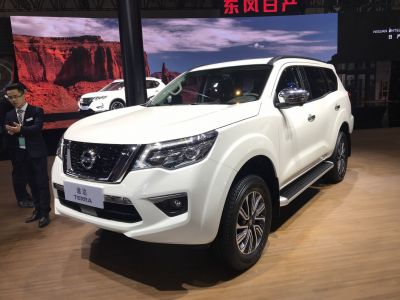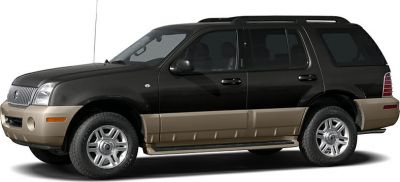 2015 Ford Everest II (U375/UA) Dimensions, Size & Specs
2015 Ford Everest II (U375/UA) Dimensions, Size & SpecsMeasurements of the 2015 Ford Everest II, engineered for optimal performance and comfort
| Dimensions | |
|---|---|
| Length: | 4892 mm192.6 in16.0 ft |
| Width: | 1860 mm73.2 in6.1 ft |
| Width (Opened Mirrors): | 2180 mm85.8 in7.2 ft |
| Height: | 1837 mm72.3 in6.0 ft |
| Ground Clearance: | 225 mm8.9 in0.7 ft |
| Trunk Capacity: | 450 liter15.9 cu ft |
| Trunk Capacity (Max): | 2010 liter71.0 cu ft |
| Weight Specifications | |
| Curb Weight: | 2239-2343 kg4936-5165 lbs |
| Maximal permitted Weight: | 2950-3100 kg6504-6834 lbs |
| Tire Specifications | |
| Rims Sizes: | 17-inch rims:
|
| Tire Sizes: |
|
The Ford Everest II (U375/UA), produced from 2015 to 2018, is a robust mid-size SUV designed to combine spaciousness with off-road capability. Measuring 4892 mm (192.5 inches) in length and 1860 mm (73.2 inches) in width, the vehicle offers a commanding road presence. Including the opened mirrors, the width expands to 2180 mm (85.8 inches), which is important for city parking and narrow roads. The height of 1837 mm (72.3 inches) adds to its SUV stature without compromising accessibility.
Weighing between 2239 and 2343 kg (4939 to 5167 lbs) curb weight, the Everest II maintains a sturdy build, with a maximum weight capacity ranging from 2950 to 3100 kg (6503 to 6834 lbs), reflecting its capability to handle heavy loads and towing demands efficiently. Ground clearance is a notable 225 mm (8.9 inches), supporting excellent off-road performance and safe navigation over uneven terrain.
Storage capacity is versatile, starting at 450 liters (15.9 cubic feet) of luggage space with all seats occupied. When the rear seats are folded, the cargo volume expands impressively to 2010 liters (70.9 cubic feet), enabling larger cargo transport suitable for family trips or adventure gear.
Rim sizes range from 17 to 20 inches with dimensions of 8J x 17, 8J x 18, and 8.5J x 20, paired with multiple tire sizes including 265/65 R17, 265/60 R18, and 265/50 R20, providing options for performance and comfort based on driving preferences.
Overall, the Ford Everest II SUV balances size, utility, and ruggedness, making it an ideal choice for those seeking a practical yet capable vehicle for both urban and off-road conditions.
Discover the standout features that make the 2015 Ford Everest II a leader in its class
Have a question? Please check our knowledgebase first.
The Ford Everest II (U375/UA) produced between 2015 and 2018 has overall dimensions that define its strong presence as a mid-size SUV. It measures 4892 mm (192.5 inches) in length, 1860 mm (73.2 inches) in width without mirrors, and 1837 mm (72.3 inches) in height. These dimensions allow the Everest II to offer a spacious cabin while maintaining a robust and muscular exterior design suitable for a variety of driving conditions, from urban environments to off-road adventures.
The Ford Everest II's width with mirrors unfolded is 2180 mm, which equals approximately 85.8 inches. This extended width is important for practical considerations such as navigating through tight parking spaces or narrow roads. While the body width is 1860 mm, adding opened mirrors increases the vehicle's footprint, which is critical for driver awareness and helps assess whether the vehicle can safely pass through confined areas without risking damage to the mirrors.
The Ford Everest II offers a generous ride height or ground clearance of 225 mm, which is about 8.9 inches. This elevated clearance is a significant advantage for off-road enthusiasts, allowing the SUV to pass over rocks, rough terrain, and uneven surfaces without damaging the underside of the vehicle. High ground clearance also contributes to better water wading capability and improved visibility for the driver, making it well suited for adventurous driving conditions.
The curb weight of the Ford Everest II ranges from 2239 to 2343 kg (4937 to 5168 lbs), while the maximum permissible weight ranges from 2950 to 3100 kg (6503 to 6835 lbs). This means the vehicle is relatively heavy, which translates to a stable and comfortable ride on highways and rough surfaces. The maximum weight capacity indicates the total weight the SUV can safely carry, including passengers, cargo, and the vehicle itself. This makes the Everest II practical for family trips as well as heavy-duty use such as towing and transporting equipment.
The Ford Everest II provides ample luggage capacity to meet diverse needs. With all seats in place, it offers 450 liters (approximately 15.9 cubic feet) of cargo space, sufficient for everyday luggage and groceries. When the rear seats are folded down, this capacity expands significantly to 2010 liters (about 70.9 cubic feet), allowing for the transportation of larger items such as sports equipment, camping gear, or bulkier cargo. Such versatility makes the Everest II a practical choice for both daily commuting and recreational activities.
A standard single-car garage typically measures about 3000 mm (118 inches) in width and roughly 6000 mm (236 inches) in length. The Ford Everest II, at 4892 mm (192.5 inches) in length and 1860 mm (73.2 inches) wide without mirrors, fits comfortably within these dimensions. However, when accounting for the mirrors opened width of 2180 mm (85.8 inches), caution is advised when maneuvering the vehicle in narrower spaces to avoid mirror damage. The height of 1837 mm (72.3 inches) is well within most garages that commonly allow clearance of over 2000 mm (79 inches). Overall, the Everest II fits into a standard garage but requires mindful parking due to the mirror width.
Compared to its predecessor, the Ford Everest II features notable increases in both size and weight, reflecting improvements in interior space, safety features, and on-road comfort. Generally, the Everest II is longer, wider, and taller, offering more passenger room and luggage space. The curb weight has also increased to between 2239 and 2343 kg (4937 to 5168 lbs) from the previous generation's lighter build, due in part to added safety technologies and bulkier components. These changes contribute to enhanced driving dynamics and a more imposing road presence, though they may affect fuel efficiency slightly compared to the earlier model.
Within the competitive mid-size SUV segment, the Ford Everest II holds its own with robust dimensions and flexible luggage space. Its length of 4892 mm (192.5 inches) and width of 1860 mm (73.2 inches) position it competitively alongside rivals such as the Toyota Fortuner and Mitsubishi Pajero Sport, which often have similar or slightly smaller footprints. The Everest II's luggage capacity of 450 liters (15.9 cubic feet) with seats up and 2010 liters (70.9 cubic feet) with rear seats folded is among the more generous in its class, especially when considering its third-row seating options, offering enhanced practicality for families and adventure seekers alike.
The Ford Everest II is equipped with a variety of rim sizes, including 8J x 17 inches, 8J x 18 inches, 8.5J x 18 inches, and 8.5J x 20 inches, paired with tire sizes like 265/65 R17, 265/60 R18, and 265/50 R20. Larger rims usually improve the SUV's aesthetic appeal and can enhance handling by reducing sidewall flex, but they may slightly reduce ride comfort due to lower-profile tires. Smaller rims with higher-profile tires generally offer a softer ride and better off-road capability due to increased tire sidewall height that absorbs impacts. The range of tire and rim options allows owners to tailor the Everest II’s handling and comfort to their driving preferences and conditions.
The Ford Everest II, produced from 2015 to 2018, brought significant improvements over its predecessor in terms of technology, safety, and comfort. This generation introduced a more modern and rugged exterior design, advanced engine options including efficient diesel variants, and enhanced off-road capabilities with advanced Terrain Management Systems. Safety features such as multiple airbags, electronic stability control, and hill descent control became standard or widely available. Inside, the Everest II offers a spacious and flexible cabin with premium materials, a modern infotainment system, and improved noise insulation, making it a well-rounded SUV choice for families and adventure enthusiasts alike.
Discover similar sized cars.

| Production: | 2021-present |
|---|---|
| Model Year: | 2021 |
| Length: | 4900 mm192.9 in |
| Width: | 2105 mm82.9 in |
| Height: | 1865 mm73.4 in |

| Production: | 2018-2021 |
|---|---|
| Model Year: | 2018 |
| Length: | 4885 mm192.3 in |
| Width: | 1850-1865 mm72.8-73.4 in |
| Height: | 1835 mm72.2 in |

| Production: | 2018-2022 |
|---|---|
| Model Year: | 2018 |
| Length: | 4903 mm193.0 in |
| Width: | 2180 mm85.8 in |
| Height: | 1837 mm72.3 in |

| Production: | 2005-2010 |
|---|---|
| Model Year: | 2006 |
| Length: | 4915 mm193.5 in |
| Width: | 1867 mm73.5 in |
| Height: | 1849 mm72.8 in |
